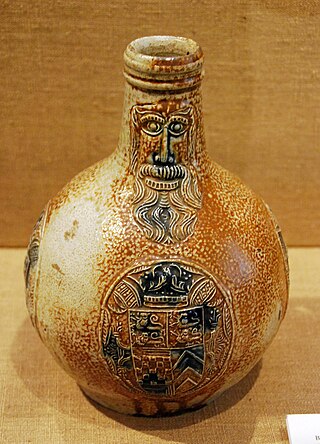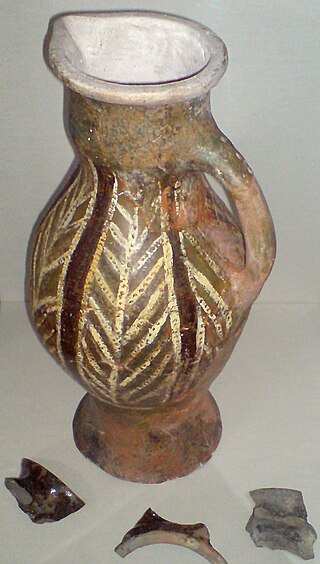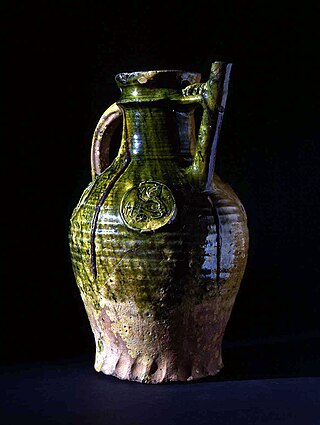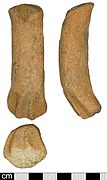Related Research Articles

Salisbury is a cathedral city in Wiltshire, England with a population of 41,820, at the confluence of the rivers Avon, Nadder and Bourne. The city is approximately 20 miles from Southampton and 30 miles from Bath.

Old Sarum, in Wiltshire, South West England, is the ruined and deserted site of the earliest settlement of Salisbury. Situated on a hill about two miles north of modern Salisbury near the A345 road, the settlement appears in some of the earliest records in the country. It is an English Heritage property and is open to the public.

Stoneware is a broad term for pottery fired at a relatively high temperature. A modern definition is a vitreous or semi-vitreous ceramic made primarily from stoneware clay or non-refractory fire clay. End applications include tableware, decorative ware such as vases.

Salt-glaze or salt glaze pottery is pottery, usually stoneware, with a glaze of glossy, translucent and slightly orange-peel-like texture which was formed by throwing common salt into the kiln during the higher temperature part of the firing process. Sodium from the salt reacts with silica in the clay body to form a glassy coating of sodium silicate. The glaze may be colourless or may be coloured various shades of brown, blue, or purple.

Clarendon Palace is a medieval ruin 2+1⁄4 miles (3.6 km) east of Salisbury in Wiltshire, England. The palace was a royal residence during the Middle Ages, and was the location of the Assize of Clarendon which developed the Constitutions of Clarendon. It now lies within the grounds of Clarendon Park.

Qingbai ware is a type of Chinese porcelain produced under the Song Dynasty and Yuan dynasty, defined by the ceramic glaze used. Qingbai ware is white with a blue-greenish tint, and is also referred to as Yingqing. It was made in Jiangxi province in south-eastern China, in several locations including Jingdezhen, and is arguably the first type of porcelain to be produced on a very large scale. However, it was not at the time a prestigious ware, and was mostly used for burial wares and exports, or a middle-rank Chinese market. The quality is very variable, reflecting these different markets; the best pieces can be very thin-walled.

Stamford ware is a type of lead-glazed earthenware, one of the earliest forms of glazed ceramics manufactured in England. It was produced in Stamford, Lincolnshire between the ninth and thirteenth centuries. It was widely traded across Britain and the near continent. The most popular forms were jugs, spouted pitchers, and small bowls. Distribution of Stamford ware has been used to map trade routes of the period.

Deritend ware is a distinctive style of medieval pottery produced in Birmingham, England in the twelfth and thirteenth centuries. There are three types of Deritend ware; a fine to moderately sandy, micaceous orange to red ware, used mainly for jugs, with some examples of bowls, dripping trays and aquamaniles, dating to the 13th to early 14th centuries; a black or, less frequently, grey ware with a brown core, also micaceous, used mainly for cooking pots/jars and less commonly for large unglazed jugs and skillets/pipkins, dating from possibly the late 12th century to the early 14th century; and a sandy brown ware with grey core used for cooking pots, dating from possibly the late 12th century to 13th century. Wasters i.e. pottery misfires have been found for all three wares in Birmingham. Glazed Deritend ware jugs were decorated with white slip lines and applied white clay strips, often roller stamped, and white clay pads, The more complex decorative schemes are in the North French style ; the decorated jugs closely resemble London-type ware and it is distinctly possible that the Deritend ware industry included migrant potters from the London area in the thirteenth century.

Laverstock is a village and civil parish on the north-east and east outskirts of Salisbury in the ceremonial county of Wiltshire, England. The parish is shaped like a figure 7 and incorporates Ford hamlet, the eastern half of the former manor of Milford, the area near the ancient settlement of Old Sarum, and part of the Hampton Park district on the edge of Salisbury.

Redware as a single word is a term for at least two types of pottery of the last few centuries, in Europe and North America. Red ware as two words is a term used for pottery, mostly by archaeologists, found in a very wide range of places. However, these distinct usages are not always adhered to, especially when referring to the many different types of pre-colonial red wares in the Americas, which may be called "redware".

Lead-glazed earthenware is one of the traditional types of earthenware with a ceramic glaze, which coats the ceramic bisque body and renders it impervious to liquids, as terracotta itself is not. Plain lead glaze is shiny and transparent after firing. Coloured lead glazes are shiny and either translucent or opaque after firing. Three other traditional techniques are tin-glazed, which coats the ware with an opaque white glaze suited for overglaze brush-painted colored enamel designs; salt glaze pottery, also often stoneware; and the feldspathic glazes of Asian porcelain. Modern materials technology has invented new glazes that do not fall into these traditional categories.

York Glazed Ware is a type of Medieval ceramic produced in North Yorkshire, England in the 12th and 13th centuries AD.

Brandsby-type Ware is a type of Medieval ceramic produced in Brandsby, North Yorkshire, England, in the 13th and 14th centuries AD.

Humber ware is a type of Medieval ceramic produced in North Yorkshire, England in the late 13th to early 16th Centuries AD.

Ham Green Pottery was produced between 1100 AD to 1250 AD at a hamlet above the village of Pill called Ham Green in the English county of Somerset.

Sandy ware, also known as Early Medieval Sandy ware, is a type of pottery found in Great Britain from the sixth through the fourteenth centuries. The pottery fabric is tempered with enough quartz sand mixed in with the clay for it to be visible in the fabric of the pot. Sandy ware was commonly used in Southeast England and the East Midlands.

Ancient Egyptian pottery includes all objects of fired clay from ancient Egypt. First and foremost, ceramics served as household wares for the storage, preparation, transport, and consumption of food, drink, and raw materials. Such items include beer and wine mugs and water jugs, but also bread moulds, fire pits, lamps, and stands for holding round vessels, which were all commonly used in the Egyptian household. Other types of pottery served ritual purposes. Ceramics are often found as grave goods.

Surrey whiteware or Surrey white ware, is a type of lead-glazed pottery produced in Britain from the 13th to the 16th centuries. The white-fired sandy earthenware was produced largely from kilns in Surrey and along the Surrey-Hampshire border. Surrey whitewares were the most commonly used pottery in London during the late medieval period. There are four classes of Surrey whiteware: Kingston-type, Coarse Border ware, Cheam whiteware and Tudor Green ware.

Border ware is a type of post-medieval British pottery commonly used in the South of England, London and then later in the early American colonies beginning in the sixteenth and ending in the nineteenth century with a height of popularity and production in the seventeenth century. The lead-glazed, sandy earthenware was produced from kilns along the border between Hampshire and Surrey. There are two classes of Border ware, fine whitewares and fine redwares.

Highhays Ware is a term used for medieval pottery produced at the Highhays pottery site in Kilkenny, Ireland. It was previously referred to as "Kilkenny-type ware". The pottery found during the excavations at the site included jugs, cooking pots, storage jars, money boxes, parts of pottery like spouts and ridge tiles or parts thereof, in total "42 sherds of [...] pottery and 160 ridge-tile fragments" from the kiln alone.
References
- ↑ Robinson, Paul (2002). "Salisbury and South Wiltshire Museum Medieval Catalogue". Wiltshire Archaeological Review. Devizes: Wiltshire Archaeological and Natural History Society. 95: 294.
- ↑ "Historic England Research Records Monument Number 217628". www.heritagegateway.org.uk. Historic England. Archived from the original on 18 December 2023. Retrieved 18 December 2023. The Scheduled Monument number is 1003252.
{{cite web}}: CS1 maint: postscript (link) - 1 2 Every, Rachel. "Old Sarum Water Pipeline Specialist Reports" (PDF). Salisbury: Wessex Archaeology. p. 5. Archived (PDF) from the original on 5 December 2021. Retrieved 18 December 2023.
- ↑ "Jug late 13th century". Victoria and Albert Museum. Archived from the original on 20 December 2023. Retrieved 20 December 2023.
- 1 2 3 4 Musty, John; Algar, D. J.; Ewence, P. F. (1969). "The Medieval Pottery Kilns at Laverstock, near Salisbury, Wiltshire". Archaeologia . 102: 82–150. doi:10.1017/S0261340900003751.
- ↑ Spoerry, Paul (August 1989). "The Chemical Analysis of Ceramic Fabrics from Medieval Dorset and its Region" (PDF). University of Bournemouth. p. 9. Archived (PDF) from the original on 18 December 2023. Retrieved 19 December 2023.
- ↑ Locker, Martin D. (November 2012). Landscapes of Pilgrimage in Medieval Britain (PDF) (D.Phil thesis). Institute of Archaeology, University College London. p. 129.
- 1 2 "Medieval Pottery". The Salisbury Museum. Archived from the original on 15 December 2023. Retrieved 15 December 2023.
- ↑ "Digging up the past. Excavations in Salisbury, St Albans and London" . The Sphere . 30 August 1958. pp. 313/23. Retrieved 20 December 2023– via British Newspaper Archive.

